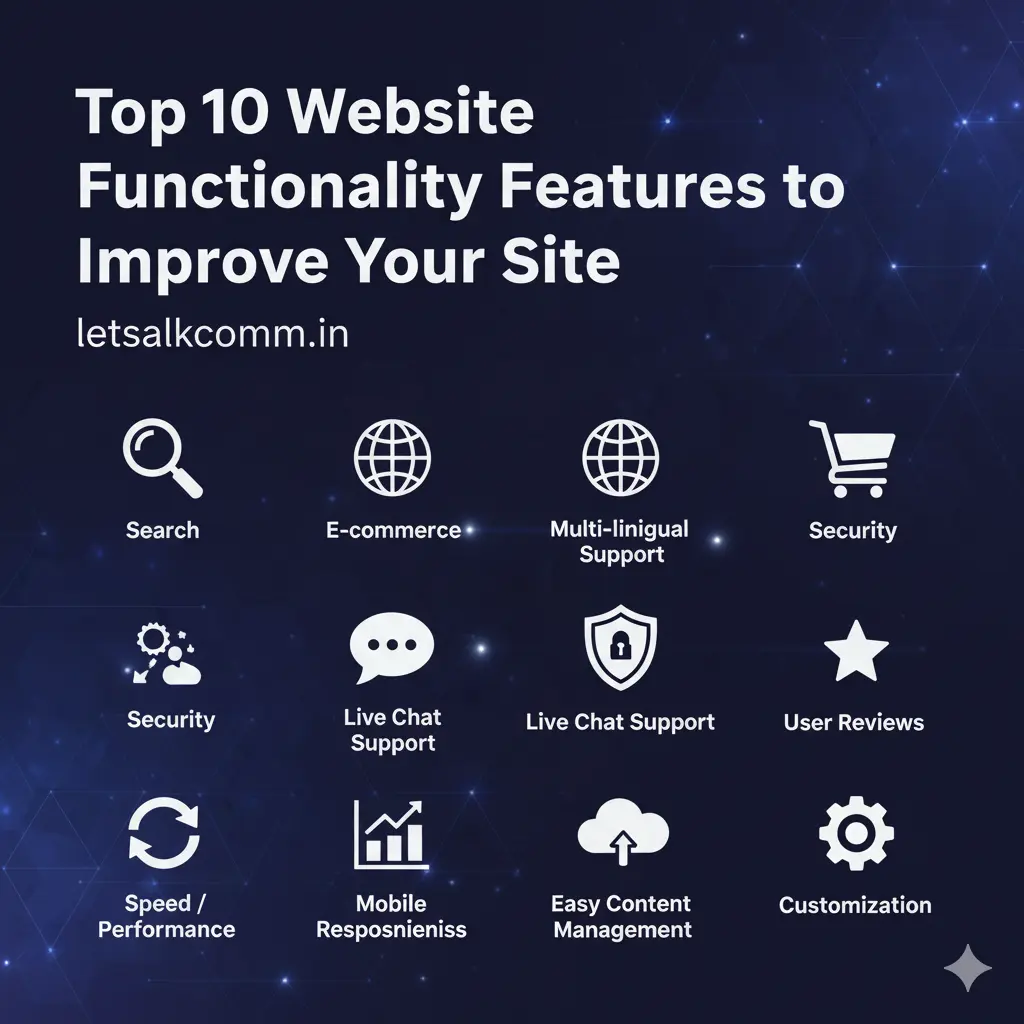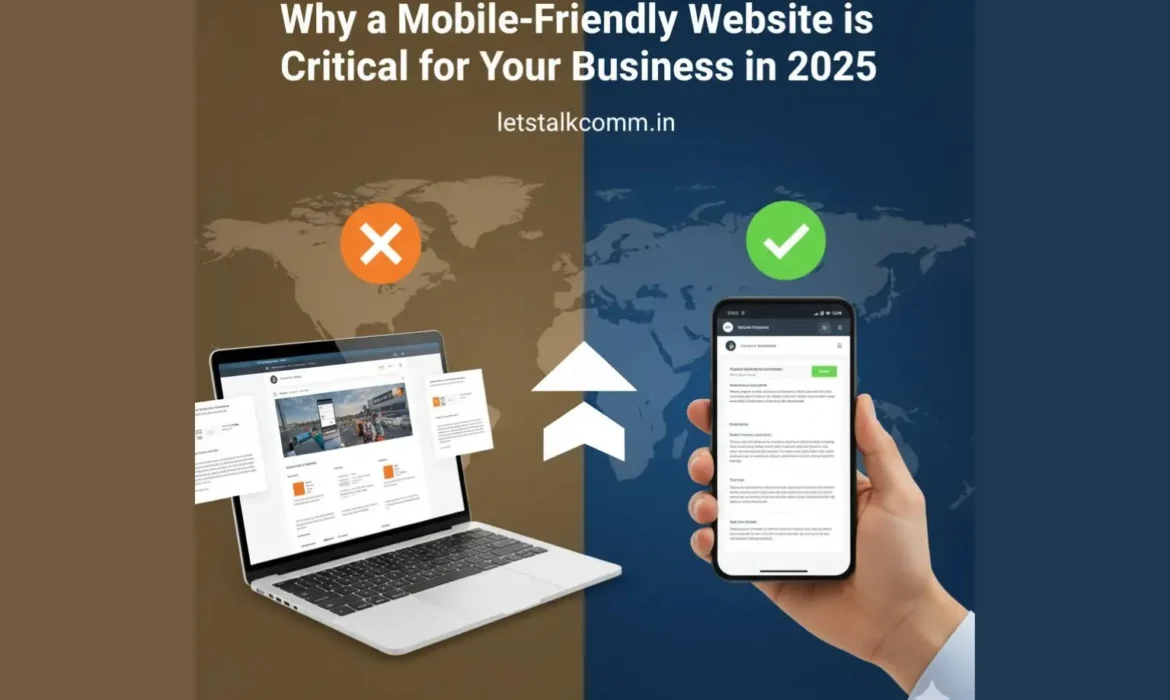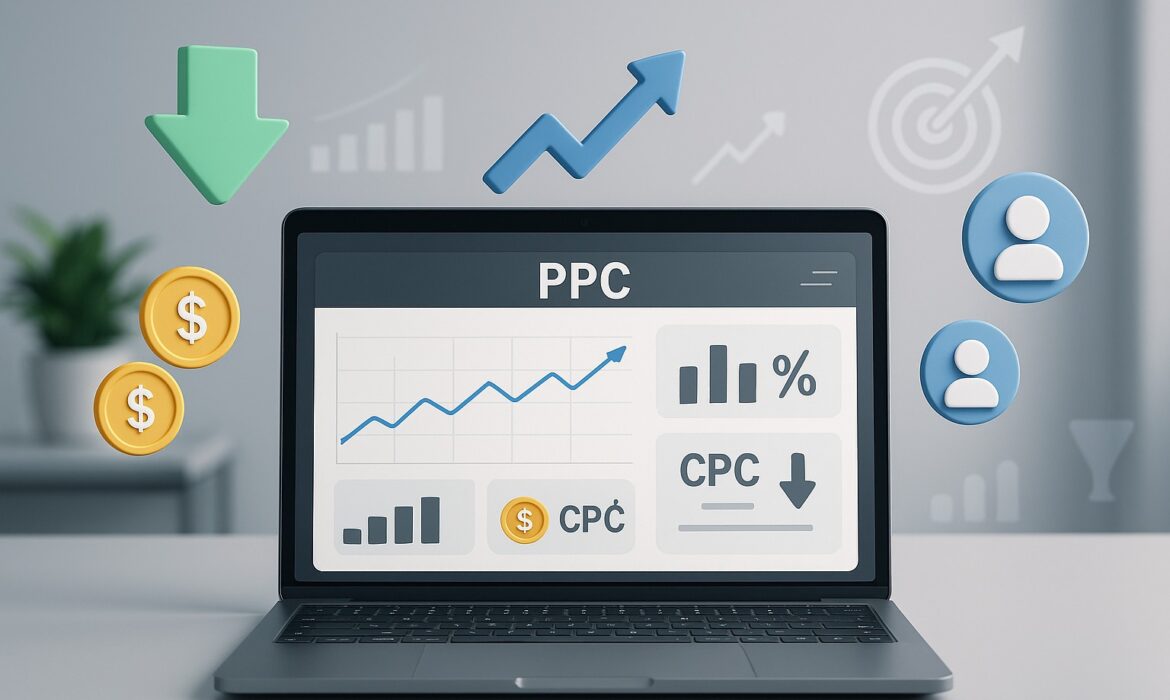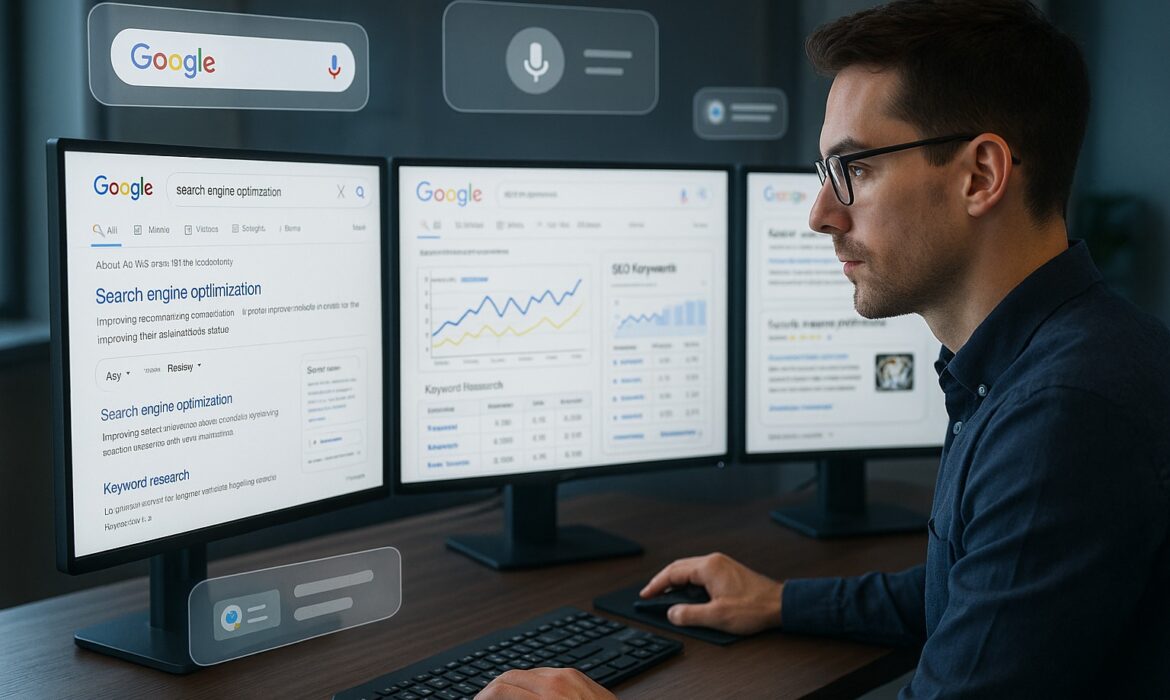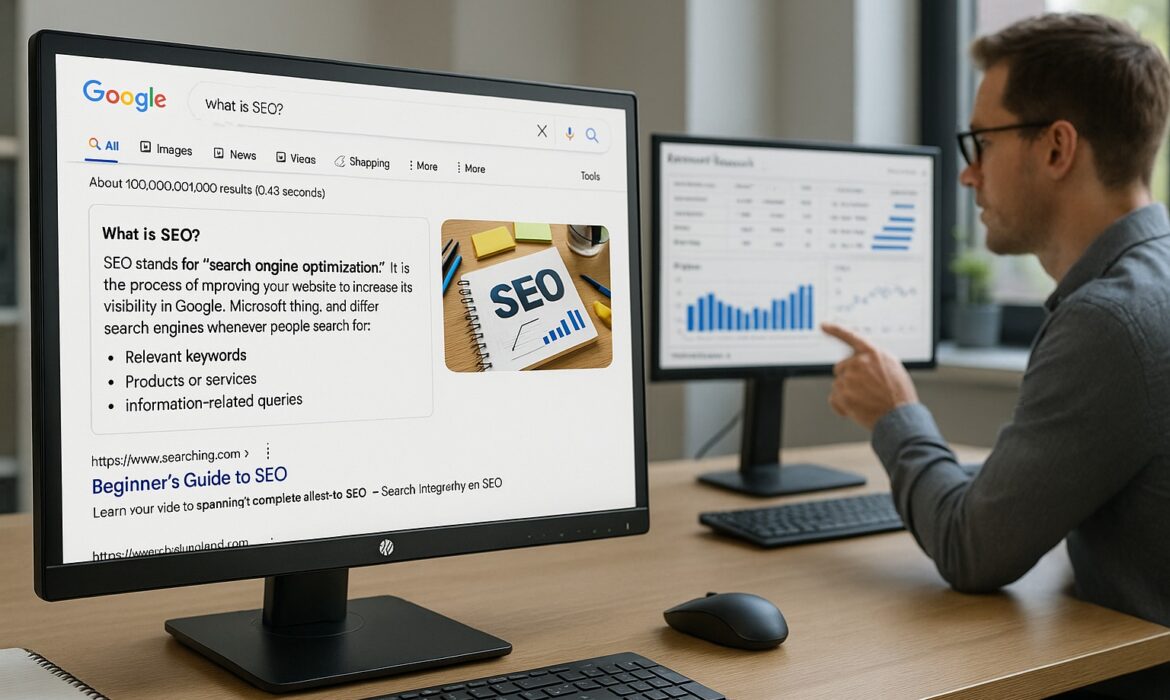Top 10 Website Functionality Features to Improve Your Site
AI is revolutionizing design. At Let’s Talk Comm, we see it as a creative partner enhancing innovation and storytelling.
The Ultimate Holiday Readiness Guide for Online Sellers: Maximize Your Q4 Sales
Want to grow sales on Amazon & Flipkart in 2025? From SEO-friendly listings to ads, reviews & big sales events here’s your complete success guide.
Why a Mobile-Friendly Website is Critical for Your Business in 2025
AI is revolutionizing design. At Let’s Talk Comm, we see it as a creative partner enhancing innovation and storytelling.
The Impact of AI in Graphic Design: Threat or Creative Solution?
AI is revolutionizing design. At Let’s Talk Comm, we see it as a creative partner enhancing innovation and storytelling.
How to Boost Sales on Amazon & Flipkart in 2025
Want to grow sales on Amazon & Flipkart in 2025? From SEO-friendly listings to ads, reviews & big sales events here’s your complete success guide.
How to make a Brand Identity That Stands Out
Your brand identity is more than a logo — it’s how your business is seen and remembered. Learn the key steps to build a consistent, memorable, and trustworthy brand.
How to Lower PPC Costs Without Losing Leads
Running PPC advertisements can get expensive — especially in 2025 as competition increases. Many businesses face the challenge of rising ad costs while trying to keep a steady flow of qualified leads. The good news is that with the right strategies, you can cut waste, maintain (or even improve) lead quality, and maximize your ROI.
In this guide, we’ll break down proven ways to lower your PPC costs without sacrificing lead quality.
1. Use Negative Keywords to Eliminate Waste
One of the simplest ways to save money is by avoiding irrelevant clicks. Negative keywords tell platforms like Google Ads not to show your ads for certain search terms.
For example:
- If you sell paid courses, add “free courses” as a negative keyword.
- If you provide premium software, exclude “trial” or “open source.”
This ensures your budget is spent only on people likely to convert, not on those who were never going to buy in the first place.
2. Focus on High-Intent Keywords
Not all keywords drive the same type of traffic. Broad keywords may bring clicks, but they often attract people who are still researching and not ready to buy. Instead, focus on keywords that signal strong intent, such as:
- Phrases including “buy,” “hire,” “get a quote,” or “near me”
- Specific product or service names, including model numbers or branded terms
High-intent keywords generally have higher conversion rates, meaning you spend less on irrelevant traffic and more on qualified prospects.
3. Improve Your Quality Score for Lower CPC
Google rewards ads that are highly relevant and provide a positive user experience. This is measured through the Quality Score, which directly influences how much you pay per click.
Here’s how to improve it:
- Match ad copy to target keywords — use the same language your audience searches for.
- Optimize landing pages — ensure they are fast, mobile-friendly, and aligned with the ad promise.
- Increase CTR — use compelling headlines, clear calls to action, and ad extensions to attract clicks.
A higher Quality Score can mean better ad placement and lower costs — a double win.
4. Optimize Ad Scheduling to Show Ads at the Right Time
Not every hour of the day (or day of the week) delivers the same value. By analyzing performance data, you can identify when your audience is most active and most likely to convert.
Use ad scheduling (sometimes called dayparting) to:
- Run ads only during high-performing hours
- Pause ads during low-conversion times
- Adjust bids for peak hours to stay competitive
This approach helps eliminate wasted spend and keeps your ads in front of prospects when they’re most likely to take action.
5. Test Ad Creatives Regularly to Prevent Fatigue
Audiences get tired of seeing the same ads repeatedly. When ad fatigue sets in, click-through rates drop and costs per lead rise.
To keep campaigns fresh and efficient:
- Rotate multiple versions of headlines and descriptions
- A/B test calls to action, visuals, and offers
- Pause underperforming ads and allocate budget to winners
Continuous testing ensures that you’re always running the most effective messages — helping control costs while maintaining engagement.
6. Use Geo-Targeting to Reach Only Relevant Locations
Serving ads everywhere can be a waste of money if you only sell in certain regions. Geo-targeting allows you to show ads only where your ideal customers are located.
Examples:
- A local service business can limit ads to its city or delivery area.
- A B2B company can focus only on countries where they operate.
By narrowing your geographic reach, you reduce wasted clicks and ensure your spend goes toward the most valuable traffic.
The Bottom Line
Lowering PPC costs isn’t about slashing budgets blindly — it’s about precision. With smarter targeting, better relevance, and ongoing optimization, you can reduce ad spend while keeping your leads strong and your campaigns profitable.
Top 7 SEO Trends Businesses Should Concentrate on in 2025
In 2025, SEO isn’t just about adding keywords to your website. Search is evolving at a rapid pace. People are using AI chatbots, voice assistants, visual tools, and traditional search engines in very different ways.
If you want your brand to stay visible, you need to understand user intent, new search formats, and how to make your brand discoverable across multiple platforms — including AI-driven environments.
Below, we break down the 7 biggest SEO trends shaping the year ahead and what you can do to prepare.
1. Answer Engine Optimization (AEO)
AI-powered assistants like ChatGPT, Gemini, Copilot, and Alexa are becoming the first stop for users seeking answers. Instead of visiting a website, people often get a summarized response directly in the chat window.
What this means for businesses:
- You need to structure your content so AI tools can understand and pull from it.
- A conversational tone, question-and-answer formats, and strong schema markup make it easier for AI models to find, trust, and use your content.
Action steps:
- Write in a natural, conversational tone.
- Use Q&A-style headlines (H2s and H3s).
- Add structured data (FAQ, HowTo, Product schemas) to make your content machine-readable.
2. Zero-Click Search Optimization
Google and other search platforms often answer questions directly on the results page — without sending traffic to any website. This is what we call a “zero-click” search.
While that sounds like a loss, it’s actually a huge visibility opportunity. If your content is the one being displayed, your brand gains authority, and users may still click if they need more details.
Action steps:
- Target featured snippets by answering common questions clearly and concisely.
- Provide direct answers in 50–60 words for high-volume queries.
- Use bullet points or numbered lists to increase snippet chances.
3. Voice Search Optimization
More users are asking full, natural questions through smart speakers, in-car systems, and mobile voice assistants. Voice queries often have long-tail keywords and local intent.
Action steps:
- Focus on conversational long-tail keywords (“How do I…?”, “What’s the best…?”).
- Optimize for “near me” searches with accurate local listings and location pages.
- Make sure your website loads quickly on mobile — voice users are often on-the-go.
4. Visual Search Optimization
Tools like Google Lens, Pinterest Lens, and Bing Visual Search are increasingly popular. Users can now snap a picture instead of typing a query.
Action steps:
- Use high-quality, descriptive product images.
- Add descriptive alt text and captions.
- Apply image schema markup so search engines can understand what’s in your photos.
- Ensure your site supports fast image loading with compression and next-gen formats (like WebP).
5. Topical Authority Building
Google now rewards depth over breadth. A website that covers one topic thoroughly is more likely to rank than one that covers many topics lightly.
Action steps:
- Create content clusters — a main pillar page and multiple supporting blog posts.
- Internally link between related posts to help search engines understand your topic expertise.
- Cover all subtopics users might search for under your main theme.
6. Faster Page Speed & User Experience
Speed is not optional anymore. Slow pages lead to lower rankings, fewer conversions, and higher bounce rates.
Action steps:
- Compress images without losing quality.
- Use a Content Delivery Network (CDN) to serve content faster.
- Reduce unnecessary code (minify CSS, JavaScript, and HTML).
- Test your site with tools like Google PageSpeed Insights or GTmetrix regularly.
7. EEAT: Experience, Expertise, Authoritativeness, Trustworthiness
Google continues to refine how it evaluates credibility. In 2025, demonstrating real expertise matters more than ever.
Action steps:
- Include author bios with credentials.
- Use real case studies and success stories.
- Cite credible external sources to back up claims.
- Keep your site secure (HTTPS) and user-friendly.
Final Thoughts
SEO in 2025 is about being the best answer — whether someone is searching on Google, asking a voice assistant, or using an AI chatbot.
If your brand is present, fast, credible, and easy to understand, you’ll stay ahead of competitors and win more organic opportunities — even in a search landscape where clicks are no longer guaranteed.
Content That Converts: 5 Strategies for 2025
Search engine optimization continues to change as Google and other platforms refine the way they deliver answers. One of the most powerful opportunities today is appearing in featured snippets—the highlighted boxes that display quick answers above standard search results. Securing this position, often called “position zero,” can dramatically increase visibility and credibility. In 2025, competition for these placements is fierce, and businesses need to adapt their strategies accordingly. Understanding how featured snippets SEO works and how to optimize for it can make the difference between being overlooked and being the go-to answer.
What Are Featured Snippets?
Featured snippets are special search results that appear at the very top of Google’s results page. They are designed to answer questions quickly and directly without requiring users to click through to a website. These snippets can take several forms: a paragraph of text, a list, a table, or even a video.
For example, if someone asks, “What is the capital of Japan?” the featured snippet will provide “Tokyo” in bold, often with a supporting sentence pulled from a trusted source. While these snippets may reduce website clicks, they dramatically boost brand visibility and establish authority. This makes them one of the most important elements in modern SEO strategies.
Why Featured Snippets Matter in 2025
As voice search and AI-driven search tools become more common, featured snippets play an even bigger role. Voice assistants often read featured snippet content aloud as the definitive answer. Similarly, AI-powered overviews in search results rely heavily on structured, clear answers that resemble snippets.
For businesses, appearing in these results means being recognized as a trusted authority. Even if users don’t click right away, brand exposure is invaluable. In competitive industries, mastering featured snippets SEO can give companies an edge over rivals by keeping them top-of-mind with potential customers.
Types of Featured Snippets
To rank effectively, it’s important to understand the main snippet types.
Paragraph snippets: These provide short, direct explanations or definitions, often in 40–50 words.
List snippets: These display step-by-step instructions or rankings, such as “top 10 travel destinations.”
Table snippets: These are used for data-heavy content like pricing comparisons or schedules.
Video snippets: These increasingly come from platforms like YouTube, especially for “how-to” queries.
Each type requires slightly different optimization strategies, but they all reward content that is clear, structured, and useful.
Researching the Right Keywords
Ranking for snippets begins with keyword research. Instead of only targeting broad terms, businesses should focus on question-based queries and long-tail keywords. Many snippets appear for searches starting with “what,” “how,” or “why.” For example, “how to bake sourdough bread” is far more likely to generate a snippet than simply “sourdough bread.”
In 2025, keyword tools provide deeper insights into which queries already trigger snippets. By identifying these opportunities, businesses can tailor their content to compete directly for featured positions. Building a list of target questions within your niche is the foundation of featured snippets SEO.
Structuring Content for Snippets
Search engines favor content that is easy to scan and extract. To improve your chances of winning snippets, structure your content with clear headings, subheadings, and concise answers. For instance, if targeting the query “What is renewable energy?”, include a section with that exact heading followed by a 40–50 word definition.
Lists should be formatted with numbers or bullet points, while tables should be simple and well-labeled. Even within long-form content, adding these “snippet-friendly” sections helps search engines identify the best answer to showcase. Remember, the goal is to answer quickly while providing additional depth further down the page.
Leveraging Schema Markup
Schema markup, also known as structured data, is increasingly important for helping search engines interpret content. By marking up definitions, FAQs, recipes, events, or product details, businesses can improve their chances of being selected for snippets.
In 2025, schema is especially critical as AI-driven search tools rely on structured data to pull accurate answers. Implementing schema signals that your content is reliable and makes it easier for search engines to feature your site in snippets.
Optimizing for Voice and AI Search
Because voice assistants often pull answers from snippets, optimizing for conversational queries is vital. Content should reflect natural speech patterns rather than just keywords. For example, instead of writing “best hotels New York,” you might phrase it as “What are the best hotels in New York?”
AI-powered search features also prioritize clear, well-structured responses. Aligning content with natural language and anticipating follow-up questions improves the likelihood of being featured. By thinking like your audience and providing direct, conversational answers, you strengthen your featured snippets SEO strategy.
Building Authority and Trust
Not every site is eligible for snippets. Google tends to favor content from authoritative, trustworthy sources. This means building credibility through backlinks, positive user engagement, and consistent publishing. High-quality, accurate content is rewarded over thin or overly promotional material.
In 2025, trust signals such as author expertise, up-to-date information, and transparent sourcing matter more than ever. Regularly updating articles, especially those targeting snippet queries, ensures accuracy and increases the chances of maintaining or winning featured positions.
Monitoring and Refining Snippet Performance
Winning a snippet is only half the battle; maintaining it requires ongoing monitoring. Competitors are constantly optimizing their own content, and Google updates its algorithm frequently. Using SEO tools to track which queries trigger snippets and whether your site holds the position is essential.
If you lose a snippet, analyze what changed—did a competitor provide a more concise answer, or did Google shift the format type? By refining your content regularly, you can increase the chances of regaining or maintaining top visibility.
Conclusion
In 2025, featured snippets are central to how users discover information online. They power voice assistants, enhance AI-driven search experiences, and establish trust by placing answers directly in front of users. For businesses, mastering featured snippets SEO is one of the most effective ways to boost visibility and authority.
The path to success lies in researching question-based queries, structuring content clearly, implementing schema markup, and providing concise, conversational answers. By focusing on user intent and continuously refining content, businesses can position themselves as the go-to source for quick, reliable information.
Ranking for featured snippets may not always drive immediate clicks, but it builds long-term brand awareness and credibility—key factors in any sustainable digital strategy. In the end, the websites that adapt to these evolving search dynamics will continue to thrive in an increasingly competitive online world.
Zero-Click SEO: How to Win in Google Without Clicks
The way people search has changed. Years ago, most searches led to a click on a website, but today Google often provides answers directly on the results page. This shift has given rise to zero click SEO, a strategy that focuses on gaining visibility and trust even when users do not actually click through to a site. For businesses and creators, understanding how to win in this new environment is critical to staying relevant.
Understanding Zero-Click SEO
Zero-click results appear when Google satisfies a searcher’s intent directly on the search page. These can take the form of featured snippets, knowledge panels, definitions, maps, or even calculators. Instead of driving traffic to a site, the answer is shown immediately, leaving many website owners frustrated as impressions grow but clicks stagnate.
However, the reality is that zero click SEO is not necessarily a threat. When used strategically, it allows brands to build awareness, authority, and recognition. People may not click the first time, but when they later need to make a purchase or dive deeper, they are more likely to choose the source they already saw on Google.
Why Zero-Click Searches Are Increasing
Several factors explain why zero-click searches are growing rapidly. Google’s goal has always been to provide the fastest answers, and with mobile usage dominating, people want instant information. Voice search has also contributed, as smart speakers and assistants usually read out one definitive answer.
Additionally, snippets, People Also Ask sections, and knowledge graphs make results more interactive. While this may reduce website visits, it increases trust in Google’s platform and highlights reliable sources. For businesses, this means adjusting strategies to align with the way information is being consumed today.
Featured Snippets and Position Zero
The most powerful example of zero click SEO is the featured snippet, often called “position zero.” This is the highlighted box at the top of search results that pulls content from a website to provide a direct answer. Getting placed here significantly boosts visibility, even if users do not click through.
To optimize for snippets, content should be structured with clear definitions, lists, and short paragraphs that directly answer search queries. Formatting answers in simple, concise sentences increases the likelihood of being chosen by Google’s algorithm. While clicks may be fewer, the branding value of being featured at the very top is immense.
Knowledge Panels and Brand Authority
Another important zero-click element is the knowledge panel. These panels appear on the right-hand side of search results and contain details about companies, individuals, or products. They pull information from trusted databases, official websites, and Wikipedia.
Appearing in a knowledge panel enhances credibility. It makes a brand look authoritative, even if the user does not click. Businesses can optimize for this by ensuring consistent information across directories, claiming their Google Business Profile, and building reliable online citations.
Voice Search and Zero-Click Future
Voice search is a natural driver of zero-click results. When someone asks a smart assistant a question, the device usually reads one answer instead of offering a list of clickable results. This makes it crucial for businesses to create content optimized for conversational queries and natural language.
By focusing on FAQs, question-based headings, and schema markup, websites increase their chances of being selected as the spoken answer. While this may not directly lead to a visit, it positions the brand as the most relevant and trustworthy resource.
Balancing Visibility and Traffic
One of the biggest challenges with zero click SEO is balancing brand visibility with the loss of traffic. Many marketers initially resist it, fearing declining website visits. But a shift in perspective is needed. Instead of measuring only clicks, success should also be gauged by impressions, visibility, and long-term trust.
For example, if a business is consistently appearing in snippets or knowledge panels, users are exposed to the brand multiple times before they make a decision. That repeated exposure builds familiarity and confidence, which often translates into conversions down the line.
Optimizing Content for Zero-Click Results
To win in this landscape, content strategies need to adapt. Websites should focus on answering specific questions directly, using structured data to help Google understand the context. Creating FAQ sections, definition-style explanations, and step-by-step processes increases the chances of content being pulled for snippets.
Additionally, using schema markup for events, products, recipes, and reviews gives search engines more context. This not only helps secure zero-click placements but also strengthens overall SEO performance.
Local SEO and Zero-Click Searches
Local businesses are especially affected by zero-click searches, as map packs and business listings often appear before organic results. When someone searches for “restaurants near me” or “plumber in town,” they are more likely to interact with a Google Business Profile than click a website.
This makes optimizing local listings vital. Keeping business hours, contact details, photos, and customer reviews updated ensures better visibility. Even if users do not click through, they can call directly or visit in person, proving that zero-click visibility can drive real-world outcomes.
Measuring Success Beyond Clicks
Traditional SEO metrics like traffic and click-through rate are no longer the only indicators of success. With zero click SEO, impressions, visibility in snippets, and brand mentions matter just as much. Businesses should track how often they appear in featured snippets, how visible their knowledge panel is, and how their brand is represented in “People Also Ask” sections.
The ultimate goal is to remain present where users are searching, even if that presence does not always result in a click. By adjusting expectations and measuring broader visibility, businesses can better appreciate the benefits of zero-click opportunities.
The Future of Zero-Click SEO
As Google evolves, zero-click results will only become more common. AI-driven search features, smarter voice assistants, and more interactive results pages mean businesses must embrace this shift rather than resist it. Winning in the future of search will be less about chasing clicks and more about positioning your brand as the go-to answer source.
Zero-click strategies ensure that when users need deeper information or are ready to make a purchase, they already recognize and trust your brand. By adapting to this reality, businesses can stay ahead of the curve and turn visibility into meaningful engagement.
Conclusion
Zero-click SEO is not the end of search marketing—it is a transformation. While fewer clicks may seem discouraging at first, the visibility and authority gained from being featured directly in Google’s answers are invaluable. Businesses that embrace this shift, optimize their content for snippets, voice, and local results, and measure success beyond traffic will thrive in the evolving search landscape. Winning in zero click SEO is about being seen as the trusted answer. When businesses focus on providing clear, helpful, and structured content, they can secure top visibility, build long-term brand awareness, and ultimately influence customer decisions, even without the click.

